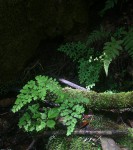| Home | > | List of families | > | Adiantaceae | > | Adiantum | > | poiretii |
Adiantum poiretii
Selected images: Click on each image to see a larger version and details of the record View all images (1)
Detailed records: Display species records QDS maps by: Google Maps Point records by Google Maps
Species details: Click on each item to see an explanation of that item (Note: opens a new window)
| Synonyms: |
Adiantum poiretii Wikstr. var. sulphureum (Kaulf.) R.M.Tryon Adiantum sulphureum Kaulf. Adiantum thalictroides Schltdl. |
| Common names: | |
| Frequency: | |
| Status: | Native |
| Description: |
Rhizome widely creeping, c. 2 mm in diameter; rhizome scales brown, appressed, lanceolate, slightly ciliate. Fronds closely spaced or frequently tufted at the end of the rhizome, herbaceous, glabrous, arching. Stipe up to 35 cm long, dark brown to black, shiny, glabrous. Lamina 2-4 pinnate, broadly ovate-deltate in outline, 30 × 25 cm. Rhachis and stalks black, shiny, glabrous. Pinnules deciduous, 1.5 × 2 cm, semicircular to obdeltate, lobed on the outer margin, veins ending in the sinuses of the lobes of the outer margin. Sori 1-6, on the undersurface of the pinnules along the outer margin, indusial flap oblong to crescent shaped, up to 2.5 mm long, glabrous, sometimes surrounded by some yellow powder. |
| Type location: |
|
| Notes: | May be confused with A. capillus-veneris which has the veins ending in the teeth of the marginal serrations. A. raddianum has much smaller pinnules and almost circular shaped sori. The pinnules of A. poiretii are also deciduous. |
| Derivation of specific name: | poiretii: named after Jean Louis Poiret (1755-1834), French botanist. |
| Habitat: | Terrestrial or lithophyte, in moist evergreen forest or medium-altitude riverine forest. |
| Altitude range: (metres) | 100 - 1600 m |
| Worldwide distribution: | Africa, Indian Ocean Islands, Asia Tristan da Cunha, tropical America. |
| National distribution: | N,T |
| Growth form(s): | Lithophyte, terrestrial. |
| Endemic status: | |
| Red data list status: | |
| Insects associated with this species: | |
| Spot characters: | Display spot characters for this species |
| Literature: |
Burrows, J.E. (1990). Southern African Ferns and Fern Allies. Frandsen, Sandton. Pages 123 - 124. (Includes a picture). Burrows, J.E. & Burrows, S.M. (1993). An annotated check-list of the pteridophytes of Malawi Kirkia 14(1) Page 86. Burrows, J.E. & Willis, C.K. (eds) (2005). Plants of the Nyika Plateau Southern African Botanical Diversity Network Report No. 31 SABONET, Pretoria Page 38. as Adiantum poiretii poiretii (Includes a picture). Chapano, C. & Mamuto, M. (2003). Plants of the Chimanimani District National Herbarium and Botanic Garden, Zimbabwe Page 3. Crouch, N.R., Klopper, R.R., Burrows, J.E. & Burrows, S.M. (2011). Ferns of Southern Africa, A comprehensive guide Struik Nature Pages 432 - 433. (Includes a picture). Da Silva, M.C., Izidine, S. & Amude, A.B. (2004). A preliminary checklist of the vascular plants of Mozambique. Southern African Botanical Diversity Network Report No. 30 Sabonet, Pretoria Page 13. Dowsett-Lemaire, F. (1989). The flora and phytogeography of the evergreen forests of Malawi. I: Afromontane and mid-altitude forests; Bull. Jard. Bot. Nat. Belg. 59(1/2) Page 24. Fischer E. & Lobin W. (2024). Checklist of Lycopodiopsida (clubmosses and quillworts) and Polypodiopsida (ferns) of Rwanda. Willdenowia 53(3) Page 165. Fischer, E. & Killmann, D. (2008). Illustrated Field guide to the Plants of Nyungwe National Park Rwanda. University of Koblenz-Landau. Page 50. (Includes a picture). Fisher E. & Killmann D. (2008). Illustrated Field guide to the Plants of Nyungwe National Park Rwanda. University of Koblenz-Landau. Pages 50 - 51. (Includes a picture). Jacobsen, W.B.G. (1983). The Ferns and Fern Allies of Southern Africa. Butterworths, Durban and Pretoria. Pages 230 - 231. (Includes a picture). Kornas, J. (1979). Distribution and ecology of the Pteridophytes in Zambia Polska Akademia Nauk Wydzial II Nauk Biologicznych Pages 66 - 67. Mapaura, A. & Timberlake, J. (eds) (2004). A checklist of Zimbabwean vascular plants Southern African Botanical Diversity Network Report No. 33 Sabonet, Pretoria and Harare Page 9. Roux, J.P. (2001). Conspectus of Southern African Pteridophyta. Southern African Botanical Diversity Network Report 13 Pages 75 - 76. Roux, J.P. (2009). Synopsis of the Lycopodiophyta and Pteridophyta of Africa, Madagascar and neighbouring islands Page 70. Schelpe, E.A.C.L.E. (1970). Pteridophyta Flora Zambesiaca Pages 112 - 113. (Includes a picture). Wursten, B., Timberlake, J. & Darbyshire, I. (2017). The Chimanimani Mountains: an updated checklist. Kirkia 19(1) Page 78. |
Other sources of information about Adiantum poiretii:
Our websites:
Flora of Burundi: Adiantum poiretiiFlora of the DRC: Adiantum poiretii
Flora of Malawi: Adiantum poiretii
Flora of Rwanda: Adiantum poiretii
Flora of Zambia: Adiantum poiretii
Flora of Zimbabwe: Adiantum poiretii
External websites:
African Plants: A Photo Guide (Senckenberg): Adiantum poiretiiAfrican Plant Database: Adiantum poiretii
BHL (Biodiversity Heritage Library): Adiantum poiretii
EOL (Encyclopedia of Life): Adiantum poiretii
GBIF (Global Biodiversity Information Facility): Adiantum poiretii
Google: Web - Images - Scholar
iNaturalist: Adiantum poiretii
IPNI (International Plant Names Index): Adiantum poiretii
JSTOR Plant Science: Adiantum poiretii
Mansfeld World Database of Agricultural and Horticultural Crops: Adiantum poiretii
Plants of the World Online: Adiantum poiretii
Tropicos: Adiantum poiretii
Wikipedia: Adiantum poiretii
| Home | > | List of families | > | Adiantaceae | > | Adiantum | > | poiretii |
